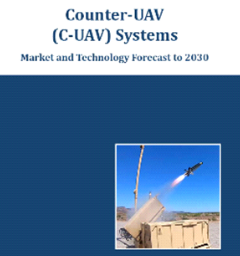Market Forecast has published a forecast for Counter-UAV (C-UAV) systems to 2030. The report covers market forecasts by Region, Platform, Product, and End-User. Country Analysis, Market and Technology Overview, Opportunities and Impact Analysis, and Leading Company Profiles, according to the press release.
Developing counter-UAV systems to tackle LSS UAVs has become a growing business, says the release. This business is young and yet developing. What is working fast in this business is developing customised solutions using COTS sensors and soft-kill technologies. This is good for urban detection, tracking and mitigation. Such C-UAV systems are in demand for airports, places of importance and securing air traffic near government offices and military bases.
For battlegrounds; solutions such as land-to-air defence using handguns, vehicle-mounted multi-layer C-UAV systems and air-to-air countermeasures are used. Many innovative ground-based fixed and mobile, vehicle-mounted and ship-mounted solutions can be seen developed in recent years.
Among other findings: The trend of launching the Centre of Excellence is seen prominently in C-UAV solution development. provide facilities for the simulation, testing, verification and validation of C-UAV programmes, and lab and field tests for sensors, directed-energy weapons and system assemblies.
Public-private partnerships are encouraged through competitions, and trial projects to avail expertise from companies knowing emerging software technologies, SwaP-enabled designs and using open architecture. Hence business scope is vast and commercial-enterprise solution providers are gaining benefits from this new trend.
For low-cost mitigation, there are ongoing experiments with directed-energy weapon systems. Laser beams and microwave-based weapon systems are in the front row. Such systems are banned to be used on humans under Protocol IV of the 1980 Convention. However, these seem allowed against Unmanned systems. These are more convenient and economical than using missiles and ammunition. Therefore, these days there is a surge in the developments, field trials and fielding of directed energy systems.
Software-defined radios and Command and Control software seem to play a crucial role in RF-based and cellular-based UAV detection and classification. Modern UAVs can fly and hop through a vast range of RF frequencies, making detection and classification a tough job. The use of SDRs and C2 software along with machine learning algorithms are becoming helpful in the classification and tracking of such UAVs.
The opportunities that we see in this business are for open-source-based, modular, small-sized solutions that can be portable. The cost of the system will be crucial and integrating these systems with remote-controlled weapon systems will be a need.
For more information visit:




